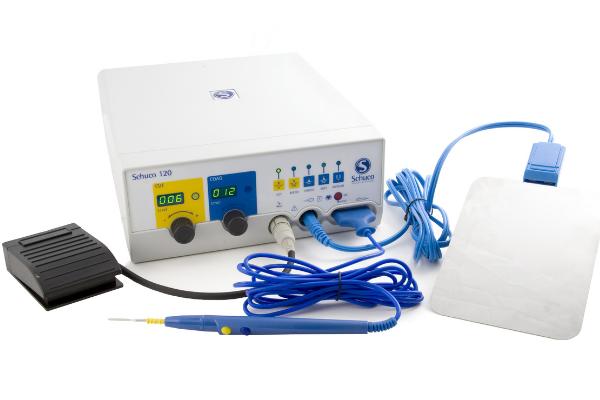Electrosurgical units (ESU) is an electrosurgical instrument that use high-frequency electrical current to cut tissue and control bleeding by causing coagulation. It heats the tissue when the high-frequency high-voltage current generated by the effective electrode tip in contact with the body, and realizes the separation and coagulation of the body tissue, thereby achieving the purpose of cutting and hemostasis.
The ESU may use a monopolar or a bipolar mode
1.Monopolar mode
In monopolar mode, a complete circuit is used to cut and solidify tissue. The circuit consists of high-frequency generator, negative plate, connector grounding pad cable and electrodes. The heating effect of high-frequency electrosurgical units can destroy the diseased tissue. It gathers high-density and high-frequency current and destroys the tissue at the point where it contacts the tip of the effective electrode. Solidification occurs when the temperature of the tissue or cell in contact with the electrode rises to the denaturation of the protein in the cell. This precise surgical effect depends on the waveform, voltage, current, tissue type, and the shape and size of the electrode.

2.Bipolar mode
The range of action is limited to the two ends of the bipolar forceps, and the damage and the range of influence of the forceps are much smaller than that of monopolar. It is suitable for blocking small blood vessels (diameter <4 mm) and fallopian tubes. Therefore, bipolar coagulation is mainly used in brain surgery, microsurgery, five characteristics, obstetrics and gynecology, hand surgery, etc. The safety of high-frequency electrosurgical units bipolar coagulation is gradually being recognized, and its application range is gradually expanding.
Electrosurgical units working principle
In electrosurgical surgery, the current flows from the electrosurgical Pencil into the human body, and flows out on the negative plate. Usual our mains frequency is 50Hz. We can also perform electrosurgery in this frequency band, but the current may cause too much stimulation to the human body and cause death. After the current frequency exceeds 100KHz, the nerves and muscles no longer react to the current. Therefore, the high-frequency electrosurgical units converts the 50Hz current of the mains into a high-frequency current exceeding 200KHz. In this way, the high-frequency energy can provide minimal stimulation to the patient. There is no danger of electric shock through the human body. Among them, the role of the negative plate can form a current loop, and at the same time reduce the current density at the electrode plate, to prevent the current from leaving the patient and returning to the high-frequency electrosurgical units to continue to heat the tissue and burn the patient.
In view of the working principle of high-frequency electrosurgical units, we need to pay attention to the following safety aspects during use:
l Safe use of negative plate
The current high-frequency electrosurgical units is equipped with high-frequency isolation technology,and the isolated high-frequency current only uses the negative plate as the only channel to return to the high-frequency electrosurgical units circuit. Although the isolated circuit system can protect the patient from burns from the alternative circuit, it cannot avoid burns caused by problems with the negative plate connection. If the contact area between the negative plate and the patient is not large enough, the current will be concentrated in a small area, and the temperature of the negative plate will rise, which may cause burns to the patient. Statistics show that 70% of the reported high-frequency electrosurgical units burn accidents are caused by the failure of the negative electrode plate or aging. In order to avoid burns of the negative plate to the patient, we must ensure the contact area of the negative plate and the patient and its conductivity, and remember to avoid repeated use of the disposable negative plate.
l Appropriate installation site
Try to be as close as possible to the operation site (but not less than 15cm) with a flat blood vessel-rich muscle area;
Remove hair from local skin and keep it clean and dry;
Do not cross the operation site left and right, and be more than 15cm away from the ECG electrode;
There should be no metal implants, pacemakers, or ECG electrodes in the loop;
The long side of the plate is close to the direction of the high-frequency current.
l Pay attention when installing the negative plate
The plate and the skin should be tightly connected;
Keep the polar plate flat and not cut or fold;
Avoid soaking the polar plates during disinfection and washing;
Children below 15Kg should choose infant plates.
l Other matters needing attention
Check whether the power supply and electrode lines are broken and the metal wires are exposed;
Connect the Electrosurgical Pencil to the machine, start the self-check, and adjust the output power after it shows that the negative plate is installed correctly and there is no alarm indication;
Avoid bypass burns: the patient’s limbs are wrapped in cloth and fixed properly to avoid skin-to-skin contact (such as between the patient’s arm and the body). Do not contact with grounded metal. Keep at least 4cm of dryness between the patient’s body and the metal bed. Insulation;
Avoid equipment leakage or short circuit: do not wind the wire around metal objects; connect it if there is a ground wire device;
After the patient moves, check the contact area of the negative plate or whether there is any displacement;
Post time: Sep-13-2021

